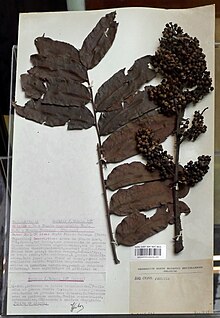Zanthoxylum gilletii
| Zanthoxylum gilletii | |
|---|---|

| |
| Scientific classification | |
| Kingdom: | Plantae |
| Clade: | Tracheophytes |
| Clade: | Angiosperms |
| Clade: | Eudicots |
| Clade: | Rosids |
| Order: | Sapindales |
| Family: | Rutaceae |
| Genus: | Zanthoxylum |
| Species: | Z. gilletii
|
| Binomial name | |
| Zanthoxylum gilletii (De Wild.) P.G.Waterman (1975)
| |
| Synonyms | |
| |
Zanthoxylum gilletii, the East African satinwood, is a tree species in the genus Zanthoxylum found in Africa. The fruits are used to produce the spice uzazi.
Chemistry
The alkaloid nitidine can be isolated from the plant.[2]
The amide alkaloids N-(4-hydroxyphenethyl)octacosanamide, N-(4-hydroxyphenethyl)hexacosanamide, N-(4-hydroxyphenethyl)decanamide, N-vanilloyltyramine and N-[O-docosanoylvanilloyl]tyramine can be isolated from the stem bark.[3] The lignan sesamin, the N-isobutylamide γ-sanshool, the acridone alkaloids 1-hydroxy-3-methoxy-N-methylacridone, arborinine, xanthoxoline and 1-hydroxy-3-methoxyacridone can also be extracted from the bark[4] as well as the alkaloids oblongine, tembetarine and magnoflorine and the flavonoid hesperidin.[5]
Text is available under the CC BY-SA 4.0 license; additional terms may apply.
Images, videos and audio are available under their respective licenses.

